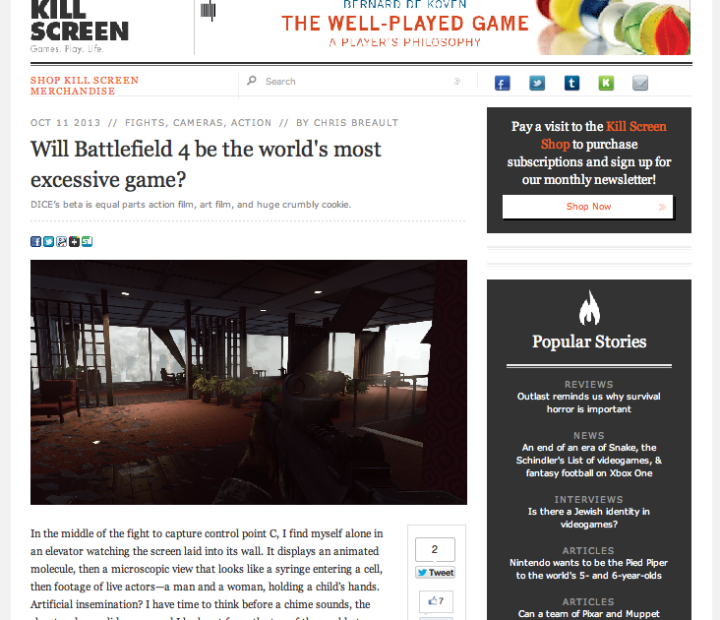On Gamic and Cinematic Excess
Authenticity Battlefield Battlefield 4 Baudrillard Botting and Wilson Cinema Studies Digital Humanities Embodiment Enactment Excess FPS Game Studies Hypertext Intertext Kill Screen Kristin Thompson Ludology Modern Warfare Op-Ed Postmodernism Shooters Simulacrum Simulation Spatiality Tarantinian Ethics TheoryThe Siege of Shanghai doesn’t have a plot for its unchecked materiality to overthrow. But it does have a structure. The five flags are laid out so as to create zones of control, chokepoints at which armor can be obstructed or destroyed, sight lines, multiple access points for infantry, etc. Returning players grok these elements almost instantly, routing themselves through the less-exposed paths and finding vantage points on well-traveled areas.
— Breault, Chris. _Kill Screen _(Oct 11 2013), http://killscreendaily.com/articles/articles/will-battlefield-4-be-worlds-most-excessive-game/
I’ve always had a special curiosity for Gameplay in Digital Games and its relation to Cinema. They’ve always seemed like estranged siblings, taking the best-selling ideas from each other in their perennial attempts to escape the shadow of the other. Shooters such as the MODERN WARFARE and BATTLEFIELD series have taken their fair share from Tom Clancy (recently deceased, God rest his soul) films and MISSION IMPOSSIBLE, while more recently we see films such as HURT LOCKER and ACT OF VALOR take on a similar taste for authenticity and proximity to the POV of a combatant. Both mediums can be argued as cinematic, if one were to take the goal of _cinematicity _to be that of the immersion of the spectator/user/audience, an immediacy that Bolter and Grusin speak so much about. But of course, one of the tricks that they don’t tell you about is that if you really want your audience to go wow, once in a while you’ve got to pull them back from the dream screen. Once in a while, you’ve got to make them realise how ludicrously unreal the thing they’re watching is.
And of course, Digital Games have one hand up on this struggle for engagement and immersion. For one, the spectator/user is granted agency, and sort of inhabits the world, which means that they can come and go as they please. There is nothing special about this. It has been going on for twenty odd years already, and brings with it the problem of reaching a significant level of immersion in the first place. But let us assume that immersion is reached — our player is sufficiently engaged in the digital game to be able to ignore the outside world for a while. How would a digital game such as BATTLEFIELD 4 offer a sort of immersion any different from a digital game from 20 years ago? And for that matter, how is it different from the immersion offered in Cinema?
I would argue that what is so different is the changing landscapes of what is being “inhabited”. Postmodernity and digitality brings to humans and mass media the “thinness” (as Fredrich Jameson puts it) of historicity, of time as it is experienced. We inhabit a landscape that is basically a hypertext now. Everything we set our eyes on draws us to what comes before and after it. We are at a point where we are beyond the debate on whether Augmented Reality should be a thing or not, whether we should be connected to simulations and digital projections that alter and obscure/reveal things that are usually invisible; we are already there.
And BATTLEFIELD 4 is an example of how (scarily) that hypertext that we inhabit, that augmented landscape which connects our experiences to other experiences (to other people’s experiences), easily spills in and out of digital spaces like that of BATTLEFIELD 4. And it is that spillage that Breault speaks of in his KILL SCREEN article. It is this spillage that, while allowing for immersion and engagement by the construction of a world believably similar to the ontic one we inhabit (a spilling into, so as to speak), there are things that spill out of this gamic space — ads that mimic real world ads, cityscapes that ape real world locations (GTA V deserves another article on this by itself) — that pull the player back from what would be traditionally regarded in film theory as suture. And it is this pulling back that allows for the “wow” moment, the “Holy Shit” that often marks a player’s experience of a game as “awesome”.
But what Breault hints at but doesn’t really point out is that this “holy shit” moment in BATTLEFIELD 4 is only possible because it is a gamic space, a space where play happens and which players inhabit. You can attempt to dress a filmic set the same way the developers dressed BATTLEFIELD 4; you can have Bruce Willis on screen scripted such that his role recalls every role he ever played, every Christmas he spent as John McClane and every non-Christmas he wasn’t, but you’ll never have the same moment of realisation that a player gets when he stops for a moment in between trigger squeezes and suddenly sees the intricately constructed world that his digital avatar is inhabiting. The player is allowed the choice, in-game, to break out of the narrative flow that dictates all films, and just simply inhabit the gamic world. This is not the cinematic excess that Kristin Thompson (quoted by Breault) talks about. This is ludic excess. This is “excess” that needs to be acted upon in order for it to be actually be “excessive”, for it to burst through the layer of immersion and engagement so valued by Hollywood so that “Holy Shit” moment can come.
–
P.S. Would like to point out that this idea of excess taking the form of “Holy Shit” is an idea taken from Botting and Wilson’s Tarantinian Ethics.
